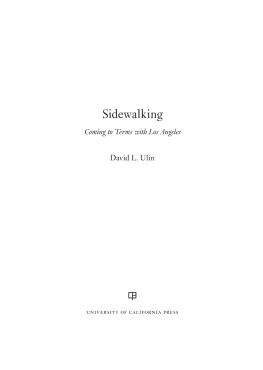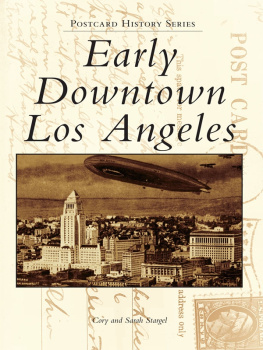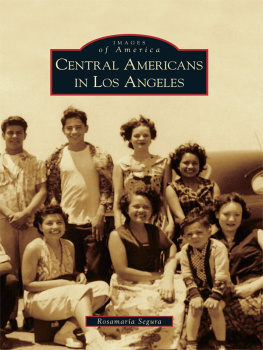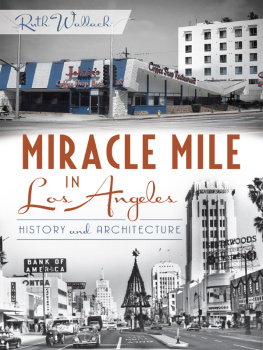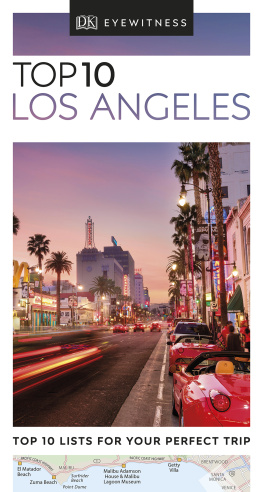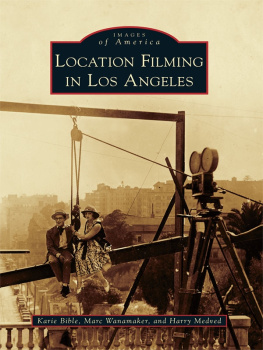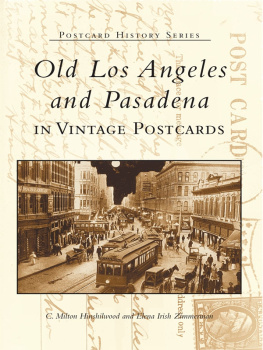David L. Ulin
University of California Press, one of the most distinguished university presses in the United States, enriches lives around the world by advancing scholarship in the humanities, social sciences, and natural sciences. Its activities are supported by the UC Press Foundation and by philanthropic contributions from individuals and institutions. For more information, visit http://www.ucpress.edu.
Some of this material has appeared, in significantly different form, in Boom: A Journal of California, Culture and Travel, Design Observer, Flaunt, ForbesLife, LA Weekly, Los Angeles , the Los Angeles Times, Places Journal , and at the 2009 Feria Internacional del Libro de Guadalajara , as well as in artist books by Robbert Flick, Michael Light, and Barbara A. Thomason, and on National Public Radios All Things Considered .
Street, Haunting appeared in The Rattling Wall 3 (Fall 2012), and was reprinted in California Prose Directory: New Writing from the Golden State , no. 2 (San Francisco: Outpost 19, 2014). An early version of Sidewalking appeared under the title A Man of the Street in West: The Los Angeles Times Sunday Magazine 126, no. 182 (June 3, 2007).
2015 by David L. Ulin
Ulin, David L., author.
Sidewalking : coming to terms with Los Angeles / David L. Ulin.
p. cm.
ISBN 978-0-520-27372-6 (cloth : alk. paper)
1. StreetsCaliforniaLos Angeles. 2. WalkingCaliforniaLos Angeles. 3. Los Angeles (Calif.)Description and travel. I. Title.
The paper used in this publication meets the minimum requirements of ANSI/NISO Z 39.481992 ( R 2002) ( Permanence of Paper ).
For Noah, fellow traveler...
There it is. Take it.
ACKNOWLEDGMENTS
I began to write about Los Angeles in the 1980s, when I still lived in New York. Back then, I thought it would be easy to understand. Navet, yes, but also my first experience of L.A.s elusiveness, the illusion of its glittering surfaces, which distract us from its elemental realities. I have lived here since 1991 and have spent much of that time trying to make sense of the cityor to make sense of it for me .
Sidewalking is a record of those attempts at sense-making, although it is more a set of impressions than a narrative. Los Angeles, after all, resists narrative, or at least master narrative; we are always making it up as we go along. Think of this book, then, as one individuals sequence of associations, defined as much by who I am, by what I want, as by the ways in which the city asserts itself.
That being said, there are many people to thank, beginning with the writers who helped unlock the city and its identity for me. Louis Adamic, Carey McWilliams, Joan Didion, Mike Davis, Norman M. Kleinthat great contrarian strain of Southern California commentators: my heroes, my heritage. Reading their work, I came to understand the complexities of this landscape, its peculiar fingerprints of place. So, too, Reyner Banham, whose Los Angeles: The Architecture of Four Ecologies remains a touchstone text, the reflections of another transplant who (as they say) went native, like the palm trees and, in a certain sense, myself. And, of course, all those who opened themselves up to my questions and investigations: Eric Brightwell, Diego Cardoso, Rick Caruso, Robbert Flick, Michael Govan, Greg Hise, and Rebecca Solnit.
I especially want to thank Alice Kimm and the students of our Spring 2014 Literature and the Urban Experience course at the University of Southern Californias School of Architecture. Our in-class conversation functioned as a kind of incubator for many of the ideas discussed in the book. Id also like to thank the Henry E. Huntington Library, in San Marino, California, for a 2009 John Randolph Haynes and Dora Haynes Foundation Fellowship, which provided early research funding and support. And I owe a particular debt to Leah and Raanan Boustan for their generosity and hospitality in sharing Eric Brightwells map of Miracle Mile.
In addition, I would like to thank Jon Christensen, Bill Deverell, Lynell George, Christopher Hawthorne, Carolyn Kellogg, Terry Morello, Miriam Pawel, Richard Rayner, Carolyn See, and Mark Haskell Smithfor friendship, conversation, and invaluable assistance in clarifying my thinking, or my confusions, about L.A. My thanks also to Kim Robinson, friend and editor at the University of California Press, and my agent, Bonnie Nadell, for their intelligence and support.
Most of all, theres my wife, Rae Dubow, who has been the catalyst for so much, including our move to Southern California, and our children, Noah and Sophiemy two Angelenos, I once referred to them. You are my heart, my life, the measure of my breathing. My gratitude for your fierce and tender love.
Street, Haunting
The eye is not a miner, not a diver, not a seeker after buried treasure. It floats us smoothly down a stream.
Virginia Woolf
There is a church I like on Cochran Avenue. Little street-corner church, adobe-style, like a mission in some minor key. I discovered it during a walk in the neighborhood, one of the interminable loops by which I mark my place in this city, east on Packard out to Cochran, south toward Pico and back around, the whole thing one vast circle, a walkabout, a songline, a way to meander my universe into being. Then one afternoon, I broke the pattern and rather than heading south, I went north, where I found the church. This morning, going against all convention, I turned right instead of left, Sven Birkerts writes in The Other Walk , describing his own inadvertent rewiring of a common saunter. Going against the grain of my usual track, seeing every single thing from the other side, was suddenly welcome. Suddenly welcome, yes, but alsofor me, at leasta means of turning the walk into a journey of discovery again. We walk, or I do, to pay attention, to see the streets, the buildings that surround us, to immerse ourselves in a world that might otherwise slip by. And yet, the paradox is that the more we walk, the less we notice, the more the passing landscape blurs to indistinction, like the backdrop in a Road Runner cartoon. Thats especially true of Los Angeles, this thirty-five-mile-per-hour city, where the very notion of the street as public space remains alien somehow. I think of Joan Didion: A good part of any day in Los Angeles is spent driving, alone, through streets devoid of meaning to the driver, which is one reason the place exhilarates some people, and floods others with an amorphous unease. Shes right, of course, although what she neglects to say is just how institutionalized this process is, in a city where we can leave our homes and drive to work, to dinner, to the movies without ever stepping outside.
Anyway, the church. I fell for it from the moment I saw it, on the corner of Cochran and Packard, built into the slow slope of a hill. There was the dome of the bell tower, faded gilt, stained glass windows brown as mica, the building stretching back half a block or so, deceptive in its depth. Even more, there was the way it fit into the neighborhoodor not the neighborhood, exactly, but the block. East of the church on Cochran was what looked like a low-slung rectory, and just beyond that, a two-story apartment house, eight units maybe, pallid stucco, flat and hulking, with a red tile roof. All three buildings looked as though theyd been put up in the 1930s, that golden age of California urban architecture, utilitarian and beautiful at once. This is the California of my first infatuation, imprinted when I was eighteen and living in San Francisco, a city I once wandered like a mendicant, memorizing its sidewalks through the soles of my feet. I remember coming across block after block much like this one: apartments next to street-corner churches. In San Francisco, the buildings were bigger, four or five stories, and cleaner, framing the Marina or Pacific Heights in blinding white. Still, there was something about this streetscape, its whisper of density, which brought me back to all those peregrinations through that other city, the randomness, the serendipity of urban space. Above the buildings, the sky was hooded, overcast, San Francisco weather, as if a fog were moving in. If I squinted, I could almost see it, one city bleeding through another, an imago, an unexpected trace.

